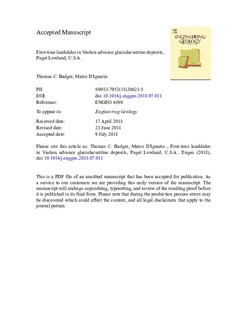| dc.description.abstract | Advance glaciolacustrine (Qglv) deposits from the last continental glaciation are widespread in the densely populated Puget Lowland and are prone to shallow landsliding. Much less frequently in historic time, new landslides propagate deeply within intact Qglv deposits. The exceptional volume and highly mobile nature of the 22 March 2014, State Route 530 (Oso) landslide generated considerable uncertainty and public concern about the likelihood for similar deep-seated failures initiating from most any slope where these deposits crop out. The primary study objectives are to utilize geotechnical data from the small data set of available published and public-domain investigations to characterize, in general terms, hydrogeologic, geotechnical and geomorphic factors and their relative contribution to initiating deep-seated landslides within intact Qglv deposits; and to inform future hazard and risk assessments for first-time landslides within these deposits. Qglv deposits are overconsolidated, very stiff to hard, laminated to massive, silt and clay. Shear strength is anisotropic, with cohesion being a significant component of bedding-parallel strength and friction dominating strength perpendicular to bedding. Hydraulic conductivity is likely also anisotropic. Multi-year records of pore pressures within Qglv deposits show no to minor seasonal flux; only minor pore pressure responses to multi-day to multi-week episodes of heavy precipitation have been detected. Back analyses using limit-equilibrium methods and peak anisotropic strength under drained conditions demonstrate initial stability of the slopes. Instability occurs near the fully softened strength. We conclude that, over the long term, loss of cohesive strength, rather than hydroclimatic pore pressure response, is the more important contributor to diminishing stability and, in some cases, initiation of first-time landslides in Qglv deposits. The shape and location of the slide surface is strongly influenced by strength anisotropy and stress state. Sliding surfaces developed near the basal contact of the Qglv deposits in all of the five studied landslides. Higher stress states associated with increasing sequence thickness of the landslide masses decrease stability. The length of the basal slide surface, and thus the aspect ratio of the landslide mass, appears to increase proportionally with sequence thickness of the landslide mass. | |
